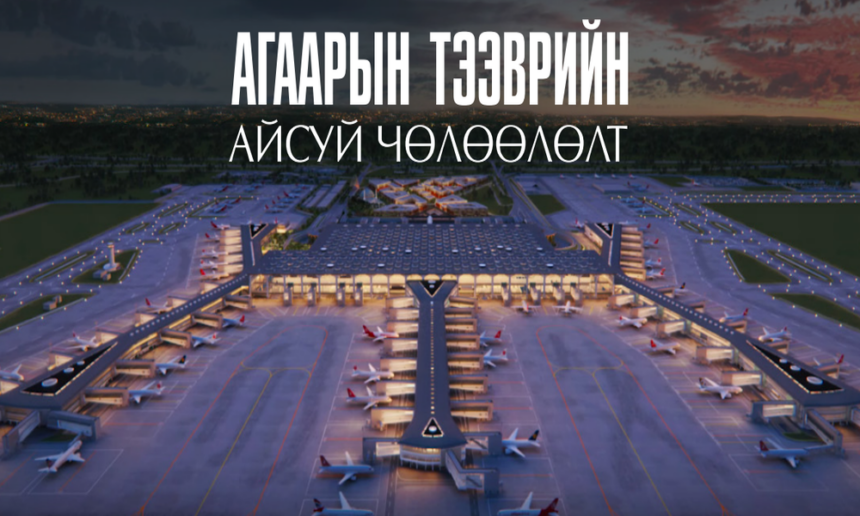Prime Minister U. Khurelsukh announced at the Mongolia Economic Forum this year that the government will develop a multi-pillar economy, invest into non-mining sectors such as agriculture, tourism, and manufacturing, and build logistics infrastructure including the new international airport in the Khushigt Valley.
Last week J. Bat-Erdene, Minister of Road and Transport Development, told the audience at the executive’s conference of air transport industry that there is an intention to liberalize air transport and reform the civil aviation industry in order to capitalize on the full potential of the new airport and develop tourism.
The current government does not have any other choice but to swiftly take measures that previous governments were not able to. The development of non-mining sectors never really progressed past talks and discussions and did not result in any substantial action. The growth of our air transport industry has slowed down as commissioning of the new airport keeps being postponed to a later date. In addition, national aviation companies are seeing more debts and growing deficits in their portfolio. These circumstances have brought a sense of urgency to liberalization of air transport in Mongolia.
Opportunity to fix mistakes
In 2013, the parliament ratified a government policy to be implemented on civil aviation until 2020. The intention of this policy was around creating free competition in the air transport sector with government regulations step by step. However, it did not deliver any substantial outcome. The story of how Eznis went bankrupt shows that private companies can never compete with state-owned ones. The two or three private aviation companies today are barely making ends meet. The authorities are not allowing a further carrier to enter the Seoul / Beijing route, which is stifling competition and strengthening the monopoly. It is also keeping ticket prices very expensive, and people are not happy about it.
A further attempt was made to allocate the remaining airlines (all airlines except for MIAT) to other international, regional, and local routes. It shrank the availability of air transport. Also, conducting a ‘one route, one airline’ policy externally has now become a huge obstacle to developing tourism.
This government has announced that it will bring changes, amend the 2020 aviation policy at the spring session of parliament, to introduce free competition to the Seoul and Beijing routes, offer equal terms to foreign aviation companies, provide air transport services to remote locations, and stabilize and expand local flights.
Although there are differences in size of economy, airlines, and flight routes, the Turkey and Mongolia examples show what the consequences are when air transport is liberated or not.
Turkey’s liberation of air transport and new airport
Turkey liberated its air transport in 2008, enabling any airline to organize flights. Their passenger turnover increased by over 200 per cent from 54 million in 2007 to 138 million in 2017. Turkey received 30 million tourists in 2017 and expects to host 50 million in 2023. In order to meet the demands of this growth over the next decade, Turkey is building the world’s largest airport. The new airport will be connected to the city center via railway and roads. In 2023, Turkish Airlines is expected to become the tenth biggest airline in the world, carrying 120 million passengers a year on its 500 aircraft. Currently, Turkish Airlines is ranked 14th in the world.
The new airport which is being built on the European coast of the Black Sea will have the capacity to receive 200 million passengers a year (7 times the size of Ataturk airport), six runways, four terminals, and a total area of 76,500 square kilometers. In order to open the airport on 29 October this year, coinciding with Turkey’s Independence Day, a total of 35,000 people are working non-stop in three shifts. The airport will have 500 hangars, 145 jet bridges, and a total area of 1.5 million square meters for all terminals, which makes it the world’s largest airport under one roof.
This project is being implemented by a consortium of Turkey’s four big construction companies under a Build-Operate-Transfer (BOT) agreement. They will construct the airport, manage its operations for 20 years, and then transfer. The initial investment was 20 billion USD, which has been followed by another 10 billion at a later stage. Also, the government will be receiving a payment of one billion USD every year starting from 2019.
Mongolia’s non-liberation of air transport and new airport
Mongolia has spent ten years talking about liberating air transport, but nothing has ever happened. According to the Ministry of Road and Transport Development, our passenger turnover increased slightly from 1.1 million to 1.2 million in 2013-2017. However, total number of arrivals and departures decreased from 16,500 to 13,500. Freight turnover also decreased from 6,500 to 5,000 tonnes. The number of flights that went over Mongolia without making a landing in the country increased from 86,000 to 110,000. It shows where our aviation sector is headed – a different direction than other countries. In 2017, Mongolia had 1.3 million passengers in international flights and 250,000 in domestic flights. These numbers are expected to increase to 1.9 million and 400,000 respectively in 2024. It has created the need to build a new airport that can meet the demands of the increased flows and help develop tourism.
The construction of the new airport is near incompletion in the Khushigt Valley in Tuv aimag’s Sergelen soum located 52 kilometers from Ulaanbaatar. The new airport will double the capacity of the current airport to receive passengers. In terms of project funding, the new airport is being built with a 40-year soft loan of 540 million USD from Japan, and the road connecting it with Ulaanbaatar is being built with a loan from China. The completion date kept extending, and the current projection points to November this year.
The airport will be managed through a concession agreement with Japan, which means that this joint venture will operate the airport for 30 years and repay the Japanese loan. The Japanese management will allow for increase in revenue, introduction of know-how, and transformation of the new airport into a regional hub.
Istanbul is a hub that connects Asia with Europe. Ulaanbaatar is a city located in the middle of the shortest route that connects Asia and North America over North Pole. Mongolia is a landlocked country with a big area of territory, so our biggest connection to the global business should be air transport. But we are still yet to capitalize on this opportunity.
If Mongolia liberates its air transport, many companies will be operating flights, which will increase the number of passengers and result in free competition. This would lead to cheaper tickets and a revolution in developing tourism. As soon as this kind of competition comes into existence, the monopoly over fuel, which comprises one third of total costs of airlines currently, will disintegrate. A 2011 report on Mongolia’s liberation of air transport suggests that the number of international flights will increase by 112 per cent after 2-3 years of liberalization. Mongolia’s relationship would improve with many other countries and our country would start providing transport services to large markets in Europe and North America. The report also says that ticket prices would be 42 per cent cheaper, which would allow people to save 121 million USD a year. International freight turnover would increase by 62 per cent, and the number of passengers in domestic flights would increase by 43-87 per cent.
Also, the report estimates there would be 117,000 new passengers on international flights, contributing 94 million USD to Mongolian economy. Approximately 21,540 jobs will be created in civil aviation, tourism, and other industries, which will increase the employment rate by 2.1 per cent. In addition, the annual contribution of nearly 100 million USD to the economy would increase Mongolia’s GDP by 2.5 per cent. These numbers are a clear indication that Mongolia needs to liberate its air transport urgently.
2018.03.28
Trans. by B.Amar












